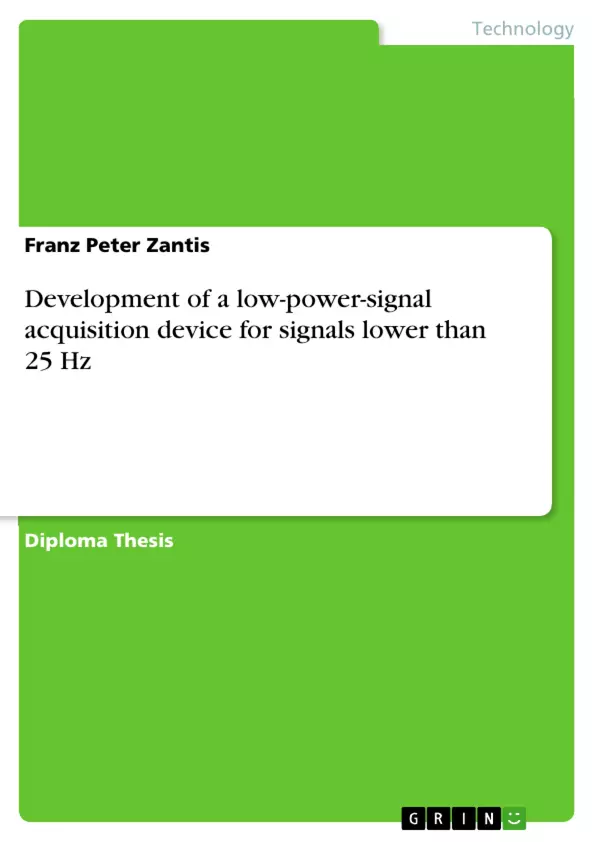Design a signal detection device for detection and digitization of weak signals with frequencies up to 25 Hz before their transmission into a personal computer (PC). The device should contain an input low-pass filter with a cutoff frequency of 25 Hz, a preamplifier, microcontroller MSP430F2013 for digitization and preparation of the digitized signals for transmission into the PC via USB interface.
Inhaltsverzeichnis (Table of Contents)
- Assignment
- Concepts
- Using the sound board of a personal computer
- Using the USB-Interface
- Low-pass-filter
- Motivation to use a low-pass-filter before digitizing
- Kinds of low-pass-filters
- Development of Butterworth-low-pass filters in general
- Designing a Butterworth low-pass filter of 6th order
- Measurement results
- Digitising and preparation of the signal
- Sampling
- Quantization
- Coding
- Requirements for digitising ELF-signals
- Anti-aliasing filter
- Sample frequency
- Resolution
- Microcontroller and adapting circuits
- Sigma-Delta-ADC
- Data exchange
- The SPI-Bus in general
- Initialization of SPI with the MSP430F2013 microcontroller
- USB-Interface
- Requirements to transfer the data into the compute
- The IO-Warrior56 (IOW56)
- Normal mode function
- Special mode function
- Interaction
- Power supply
- Software
- Appendix
- Circuit diagram
- Board, layout and bill of material
- Used formulaic symbols
- Used equipment
- List of sources
Zielsetzung und Themenschwerpunkte (Objectives and Key Themes)
This diploma thesis aims to develop a low-power signal acquisition device for weak signals with frequencies up to 25 Hz. This device should be capable of digitizing and transmitting the data to a personal computer via a USB interface. The device is intended for use in various applications, including the measurement of extremely low-frequency (ELF) signals. The focus is on creating a cost-effective and user-friendly device that is easy to build and operate.
- Design and development of a low-power signal acquisition device for frequencies up to 25 Hz
- Digitization and transmission of acquired data to a personal computer via a USB interface
- Implementation of a low-pass filter to ensure accurate signal processing
- Selection and application of appropriate hardware components, including a microcontroller and an analog-to-digital converter
- Development of software for data acquisition and processing
Zusammenfassung der Kapitel (Chapter Summaries)
- Assignment: This chapter outlines the task of designing and developing a signal acquisition device for detecting and digitizing signals within the extremely low-frequency (ELF) range (0 Hz
- Concepts: This chapter explores various methods for capturing and transmitting the signals. It discusses the use of personal computer sound boards and USB interfaces as potential options for data transfer.
- Low-pass-filter: This chapter focuses on the importance of using a low-pass filter before digitizing signals. It explores different types of low-pass filters and details the development and design of a sixth-order Butterworth low-pass filter. Measurement results from the filter implementation are also presented.
- Digitising and preparation of the signal: This chapter delves into the processes involved in digitizing the acquired signal, including sampling, quantization, and coding. It examines the specific requirements for digitizing ELF-signals, addressing aspects like anti-aliasing filtering, sample frequency, and resolution. The role of the microcontroller and associated circuits, including the Sigma-Delta-ADC, in the digitization process is also discussed.
- Data exchange: This chapter covers the use of the SPI-Bus for data exchange. It explains the general functionality of the SPI-Bus and details the initialization process of the SPI interface with the MSP430F2013 microcontroller.
- USB-Interface: This chapter focuses on the requirements for transferring data into the computer. It introduces the IO-Warrior56 (IOW56) as a potential USB interface solution. The normal and special mode functions of the IOW56 are explored.
Schlüsselwörter (Keywords)
The thesis revolves around the design and development of a low-power signal acquisition device for frequencies up to 25 Hz, focusing on the acquisition and digitization of weak signals. Key aspects include signal processing using low-pass filters, specifically the Butterworth filter, and the application of a microcontroller (MSP430F2013) and a Sigma-Delta-ADC. Data exchange via the SPI-Bus and the use of a USB interface (IO-Warrior56) are also crucial components.
- Quote paper
- Dipl.-Ing. Franz Peter Zantis (Author), 2012, Development of a low-power-signal acquisition device for signals lower than 25 Hz, Munich, GRIN Verlag, https://www.grin.com/document/196879



